Emerging Innovations in Preoperative Planning and Motion Analysis in Orthopedic Surgery
Abstract
:1. Introduction
2. What Does Modern Preoperative Planning Consist of?
2.1. Principles and Objectives of Preoperative Planning
2.2. Information Provided by 3D Data
- (a)
- 3D CT scan
- (b)
- 3D modeling
- (c)
- 3D printing
- (d)
- Mixed reality
2.3. Clinical Applications of 3D Planning
- (a)
- Hip
- (b)
- Knee
- (c)
- Shoulder
- (d)
- Spine
- (e)
- Orthopedic oncology
- (f)
- Trauma
3. What Does Modern Motion Analysis Consist of?
3.1. Principles and Objectives of Motion Analysis
- −
- The first is kinematics. This integrates methods of joint or segmental motion analysis, i.e., analysis of the movement amplitude of two articulated bone segments caused by muscles, typically while using surface markers. It also consists of measuring spatiotemporal aspects, for example, while a patient walks on a treadmill.
- −
- The second is kinetics, which encompasses methods that evaluate the forces occurring during movement, joint moments, and applied loads. Force platforms and dynamometers are used.
- −
- The final is electromyography, which consists of measuring deep or superficial muscle activity, at rest and during movement. Electromyography can be used to evaluate the functional link that influences the other movement parameters measured by kinematics and kinetics methods.
3.2. Modern Analysis Methods for Joint Movements
- (a)
- Video analysis
- (b)
- Optoelectronic motion analysis
- (c)
- Markerless motion capture
- (d)
- Connected devices
- (e)
- Augmented reality headset
3.3. Limitations of Current Motion Analysis Methods
4. How Can Preoperative Planning and Functional Movement Analysis Be Connected?
4.1. From Morphological to Functional
4.2. Definition of Artificial Intelligence
4.3. Role of Artificial Intelligence
- (a)
- Clinical functional analysis
- (b)
- Motion analysis
- (c)
- Preoperative planning
4.4. Limitations of Artificial Intelligence
5. What Is Still Missing to Achieve Predictive Functional 4D Planning?
5.1. Soft Tissues
5.2. Defining the 4D Concept
5.3. Towards Functional 4D Planning
5.4. Using a Functional 4D Plan
- (a)
- Hip
- (b)
- Shoulder
6. Conclusions
Author Contributions
Funding
Institutional Review Board Statement
Informed Consent Statement
Data Availability Statement
Acknowledgments
Conflicts of Interest
References
- Gauci, M.-O. Patient-Specific Guides in Orthopedic Surgery. Orthop. Traumatol. Surg. Res. 2022, 108, 103154. [Google Scholar] [CrossRef] [PubMed]
- Zheng, G.; Nolte, L.-P. Computer-Aided Orthopaedic Surgery: State-of-the-Art and Future Perspectives. Adv. Exp. Med. Biol. 2018, 1093, 1–20. [Google Scholar] [CrossRef]
- Kubicek, J.; Tomanec, F.; Cerny, M.; Vilimek, D.; Kalova, M.; Oczka, D. Recent Trends, Technical Concepts and Components of Computer-Assisted Orthopedic Surgery Systems: A Comprehensive Review. Sensors 2019, 19, 5199. [Google Scholar] [CrossRef] [PubMed]
- Zheng, G.; Nolte, L.P. Computer-Assisted Orthopedic Surgery: Current State and Future Perspective. Front. Surg. 2015, 2, 66. [Google Scholar] [CrossRef]
- Rossi, S.M.P.; Mancino, F.; Sangaletti, R.; Perticarini, L.; Lucenti, L.; Benazzo, F. Augmented Reality in Orthopedic Surgery and Its Application in Total Joint Arthroplasty: A Systematic Review. Appl. Sci. 2022, 12, 5278. [Google Scholar] [CrossRef]
- Furman, A.A.; Hsu, W.K. Augmented Reality (AR) in Orthopedics: Current Applications and Future Directions. Curr. Rev. Musculoskelet. Med. 2021, 14, 397–405. [Google Scholar] [CrossRef]
- Morgan, C.; Khatri, C.; Hanna, S.A.; Ashrafian, H.; Sarraf, K.M. Use of Three-Dimensional Printing in Preoperative Planning in Orthopaedic Trauma Surgery: A Systematic Review and Meta-Analysis. World J. Orthop. 2020, 11, 57–67. [Google Scholar] [CrossRef]
- Portnoy, Y.; Koren, J.; Khoury, A.; Factor, S.; Dadia, S.; Ran, Y.; Benady, A. Three-Dimensional Technologies in Presurgical Planning of Bone Surgeries: Current Evidence and Future Perspectives. Int. J. Surg. 2023, 109, 3–10. [Google Scholar] [CrossRef] [PubMed]
- Yoon, D.J.Y.; Odri, G.-A.; Favard, L.; Samargandi, R.; Berhouet, J. Preoperative Planning for Reverse Shoulder Arthroplasty: Does the Clinical Range of Motion Match the Planned 3D Humeral Displacement? J. Pers. Med. 2023, 13, 771. [Google Scholar] [CrossRef]
- Berhouet, J.; Samargandi, R.; Favard, L.; Turbillon, C.; Jacquot, A.; Gauci, M.-O. The Real Post-Operative Range of Motion Differs from the Virtual Pre-Operative Planned Range of Motion in Reverse Shoulder Arthroplasty. J. Pers. Med. 2023, 13, 765. [Google Scholar] [CrossRef]
- Kisinde, S.; Hu, X.; Hesselbacher, S.; Lieberman, I.H. The Predictive Accuracy of Surgical Planning Using Pre-Op Planning Software and a Robotic Guidance System. Eur. Spine J. 2021, 30, 3676–3687. [Google Scholar] [CrossRef] [PubMed]
- Yu, H.; Wang, H.; Shi, Y.; Xu, K.; Yu, X.; Cao, Y. The Segmentation of Bones in Pelvic CT Images Based on Extraction of Key Frames. BMC Med. Imaging 2018, 18, 18. [Google Scholar] [CrossRef] [PubMed]
- Huang, Z.; Song, W.; Zhang, Y.; Zhang, Q.; Zhou, D.; Zhou, X.; He, Y. Three-Dimensional Printing Model Improves Morphological Understanding in Acetabular Fracture Learning: A Multicenter, Randomized, Controlled Study. PLoS ONE 2018, 13, e0191328. [Google Scholar] [CrossRef] [PubMed]
- Yang, S.; Lin, H.; Luo, C. Meta-Analysis of 3D Printing Applications in Traumatic Fractures. Front. Surg. 2021, 8, 696391. [Google Scholar] [CrossRef] [PubMed]
- Guirguis, A.; Polster, J.; Karim, W.; Obuchowski, N.; Rosneck, J.; Goodwin, R.; Subhas, N. Interchangeability of CT and 3D “Pseudo-CT” MRI for Preoperative Planning in Patients with Femoroacetabular Impingement. Skeletal Radiol. 2020, 49, 1073–1080. [Google Scholar] [CrossRef] [PubMed]
- Paul, A.V.; Udoh, I.; Bharadwaj, A.; Bokshan, S.; Owens, B.D.; Levine, W.N.; Garrigues, G.E.; Abrams, J.S.; McMahon, P.J.; Miniaci, A.; et al. Preoperative Planning with Three-Dimensional CT vs. Three-Dimensional Magnetic Resonance Imaging Does Not Change Surgical Management for Shoulder Instability. JSES Int. 2023, 8, 243–249. [Google Scholar] [CrossRef]
- Vopat, B.G.; Cai, W.; Torriani, M.; Vopat, M.L.; Hemma, M.; Harris, G.J.; Schantz, K.; Provencher, M.T. Measurement of Glenoid Bone Loss With 3-Dimensional Magnetic Resonance Imaging: A Matched Computed Tomography Analysis. Arthroscopy 2018, 34, 3141–3147. [Google Scholar] [CrossRef] [PubMed]
- Safali, S.; Berk, T.; Makelov, B.; Acar, M.A.; Gueorguiev, B.; Pape, H.-C. The Possibilities of Personalized 3D Printed Implants—A Case Series Study. Medicina 2023, 59, 249. [Google Scholar] [CrossRef] [PubMed]
- Chernchujit, B.; Tharakulphan, S.; Prasetia, R.; Chantarapanich, N.; Jirawison, C.; Sitthiseripratip, K. Preoperative Planning of Medial Opening Wedge High Tibial Osteotomy Using 3D Computer-Aided Design Weight-Bearing Simulated Guidance: Technique and Preliminary Result. J. Orthop. Surg. 2019, 27, 2309499019831455. [Google Scholar] [CrossRef]
- Kotrych, D.; Angelini, A.; Bohatyrewicz, A.; Ruggieri, P. 3D Printing for Patient-Specific Implants in Musculoskeletal Oncology. EFORT Open Rev. 2023, 8, 331–339. [Google Scholar] [CrossRef]
- Moret, C.S.; Schelker, B.L.; Hirschmann, M.T. Clinical and Radiological Outcomes after Knee Arthroplasty with Patient-Specific versus Off-the-Shelf Knee Implants: A Systematic Review. J. Pers. Med. 2021, 11, 590. Available online: https://pubmed.ncbi.nlm.nih.gov/34206259/ (accessed on 13 April 2024). [CrossRef] [PubMed]
- Ingrassia, T.; Nigrelli, V.; Ricotta, V.; Nalbone, L.; D’Arienzo, A.; D’Arienzo, M.; Porcellini, G. A New Method to Evaluate the Influence of the Glenosphere Positioning on Stability and Range of Motion of a Reverse Shoulder Prosthesis. Injury 2019, 50 (Suppl. S2), S12–S17. [Google Scholar] [CrossRef] [PubMed]
- Papotto, G.; Testa, G.; Mobilia, G.; Perez, S.; Dimartino, S.; Giardina, S.M.C.; Sessa, G.; Pavone, V. Use of 3D Printing and Pre-Contouring Plate in the Surgical Planning of Acetabular Fractures: A Systematic Review. Orthop. Traumatol. Surg. Res. 2022, 108, 103111. [Google Scholar] [CrossRef] [PubMed]
- Xiao, J.-R.; Huang, W.-D.; Yang, X.-H.; Yan, W.-J.; Song, D.-W.; Wei, H.-F.; Liu, T.-L.; Wu, Z.-P.; Yang, C. En Bloc Resection of Primary Malignant Bone Tumor in the Cervical Spine Based on 3-Dimensional Printing Technology. Orthop. Surg. 2016, 8, 171–178. [Google Scholar] [CrossRef] [PubMed]
- Shah, D.; Naik, L.; Paunipagar, B.; Rasalkar, D.; Chaudhary, K.; Bagaria, V. Setting Up 3D Printing Services for Orthopaedic Applications: A Step-by-Step Guide and an Overview of 3DBioSphere. Indian. J. Orthop. 2020, 54, 217–227. [Google Scholar] [CrossRef]
- Guo, Q.; Li, X.; Tang, Y.; Huang, Y.; Luo, L. Augmented Reality and Three-Dimensional Plate Library-Assisted Posterior Minimally Invasive Surgery for Scapula Fracture. Int. Orthop. 2022, 46, 875–882. [Google Scholar] [CrossRef] [PubMed]
- Daher, M.; Ghanimeh, J.; Otayek, J.; Ghoul, A.; Bizdikian, A.J.; Abiad, R.E. Augmented Reality and Shoulder Replacement: A State-of-the-Art Review Article. JSES Rev. Rep. Tech. 2023, 3, 274–278. Available online: https://pubmed.ncbi.nlm.nih.gov/37588507/ (accessed on 13 April 2024). [CrossRef] [PubMed]
- Berhouet, J.; Slimane, M.; Facomprez, M.; Jiang, M.; Favard, L. Views on a New Surgical Assistance Method for Implanting the Glenoid Component during Total Shoulder Arthroplasty. Part 2: From Three-Dimensional Reconstruction to Augmented Reality: Feasibility Study. Orthop. Traumatol. Surg. Res. 2019, 105, 211–218. [Google Scholar] [CrossRef]
- Moralidou, M.; Di Laura, A.; Henckel, J.; Hothi, H.; Hart, A.J. Three-Dimensional Pre-Operative Planning of Primary Hip Arthroplasty: A Systematic Literature Review. EFORT Open Rev. 2020, 5, 845–855. Available online: https://pubmed.ncbi.nlm.nih.gov/33425373/ (accessed on 12 April 2024). [CrossRef]
- Colombi, A.; Schena, D.; Castelli, C.C. Total Hip Arthroplasty Planning. EFORT Open Rev. 2019, 4, 626–632. [Google Scholar] [CrossRef]
- Zerr, J.; Chatzinoff, Y.; Chopra, R.; Estrera, K.; Chhabra, A. Three-Dimensional Printing for Preoperative Planning of Total Hip Arthroplasty Revision: Case Report. Skeletal Radiol. 2016, 45, 1431–1435. [Google Scholar] [CrossRef] [PubMed]
- Alagha, M.A.; Logishetty, K.; O’Hanlon, C.; Liddle, A.D.; Cobb, J. Three-Dimensional Preoperative Planning Software for Hip Resurfacing Arthroplasty. Bioengineering 2023, 10, 939. [Google Scholar] [CrossRef] [PubMed]
- Bishi, H.; Smith, J.B.V.; Asopa, V.; Field, R.E.; Wang, C.; Sochart, D.H. Comparison of the Accuracy of 2D and 3D Templating Methods for Planning Primary Total Hip Replacement: A Systematic Review and Meta-Analysis. EFORT Open Rev. 2022, 7, 70–83. [Google Scholar] [CrossRef] [PubMed]
- Ettinger, M.; Claassen, L.; Paes, P.; Calliess, T. 2D versus 3D Templating in Total Knee Arthroplasty. Knee 2016, 23, 149–151. [Google Scholar] [CrossRef] [PubMed]
- Pietrzak, J.R.T.; Rowan, F.E.; Kayani, B.; Donaldson, M.J.; Huq, S.S.; Haddad, F.S. Preoperative CT-Based Three-Dimensional Templating in Robot-Assisted Total Knee Arthroplasty More Accurately Predicts Implant Sizes than Two-Dimensional Templating. J. Knee Surg. 2019, 32, 642–648. [Google Scholar] [CrossRef] [PubMed]
- Klag, E.A.; Lizzio, V.A.; Charters, M.A.; Ayoola, A.S.; Wesemann, L.; Banka, T.R.; North, W.T. Increased Accuracy in Templating for Total Knee Arthroplasty Using 3D Models Generated from Radiographs. J. Knee Surg. 2023, 36, 837–842. [Google Scholar] [CrossRef]
- Jones, G.G.; Jaere, M.; Clarke, S.; Cobb, J. 3D Printing and High Tibial Osteotomy. EFORT Open Rev. 2018, 3, 254–259. [Google Scholar] [CrossRef] [PubMed]
- Micicoi, G.; Grasso, F.; Kley, K.; Favreau, H.; Khakha, R.; Ehlinger, M.; Jacquet, C.; Ollivier, M. Osteotomy around the Knee Is Planned toward an Anatomical Bone Correction in Less than Half of Patients. Orthop. Traumatol. Surg. Res. 2021, 107, 102897. [Google Scholar] [CrossRef] [PubMed]
- Jörgens, M.; Keppler, A.M.; Ahrens, P.; Prall, W.C.; Bergstraesser, M.; Bachmeier, A.T.; Zeckey, C.; Cavalcanti Kußmaul, A.; Böcker, W.; Fürmetz, J. 3D Osteotomies—Improved Accuracy with Patient-Specific Instruments (PSI). Eur. J. Trauma. Emerg. Surg. 2024, 50, 3–10. [Google Scholar] [CrossRef] [PubMed]
- Jörgens, M.; Keppler, A.M.; Degen, N.; Bachmeier, A.T.; Bergstraesser, M.; Sass, J.; Prall, W.C.; Böcker, W.; Fürmetz, J. Reliability of 3D Planning and Simulations of Medial Open Wedge High Tibial Osteotomies. J. Orthop. Surg. 2022, 30, 10225536221101699. [Google Scholar] [CrossRef]
- Fürmetz, J.; Sass, J.; Ferreira, T.; Jalali, J.; Kovacs, L.; Mück, F.; Degen, N.; Thaller, P.H. Three-Dimensional Assessment of Lower Limb Alignment: Accuracy and Reliability. Knee 2019, 26, 185–193. [Google Scholar] [CrossRef] [PubMed]
- Werner, B.S.; Hudek, R.; Burkhart, K.J.; Gohlke, F. The Influence of Three-Dimensional Planning on Decision-Making in Total Shoulder Arthroplasty. J. Shoulder Elbow Surg. 2017, 26, 1477–1483. [Google Scholar] [CrossRef] [PubMed]
- Berhouet, J.; Jacquot, A.; Walch, G.; Deransart, P.; Favard, L.; Gauci, M.-O. Preoperative Planning of Baseplate Position in Reverse Shoulder Arthroplasty: Still No Consensus on Lateralization, Version and Inclination. Orthop. Traumatol. Surg. Res. 2022, 108, 103115. [Google Scholar] [CrossRef]
- Lima, D.J.L.; Markel, J.; Yawman, J.P.; Whaley, J.D.; Sabesan, V.J. 3D Preoperative Planning for Humeral Head Selection in Total Shoulder Arthroplasty. Musculoskelet. Surg. 2020, 104, 155–161. [Google Scholar] [CrossRef] [PubMed]
- Erickson, B.J.; Chalmers, P.N.; Denard, P.; Lederman, E.; Horneff, G.; Werner, B.C.; Provencher, M.T.; Romeo, A.A. Does Commercially Available Shoulder Arthroplasty Preoperative Planning Software Agree with Surgeon Measurements of Version, Inclination, and Subluxation? J. Shoulder Elbow Surg. 2021, 30, 413–420. [Google Scholar] [CrossRef] [PubMed]
- Lilley, B.M.; Lachance, A.; Peebles, A.M.; Powell, S.N.; Romeo, A.A.; Denard, P.J.; Provencher, C.M.T. What Is the Deviation in 3D Preoperative Planning Software? A Systematic Review of Concordance between Plan and Actual Implant in Reverse Total Shoulder Arthroplasty. J. Shoulder Elbow Surg. 2022, 31, 1073–1082. [Google Scholar] [CrossRef] [PubMed]
- Sheth, U.; Theodoropoulos, J.; Abouali, J. Use of 3-Dimensional Printing for Preoperative Planning in the Treatment of Recurrent Anterior Shoulder Instability. Arthrosc. Tech. 2015, 4, e311–e316. [Google Scholar] [CrossRef] [PubMed]
- La Banca, V.; Giglio, L.; Palagi Viganó, A.V.; Michaelis, L.F.; Bonadiman, J.A.; Vieira Lima, G.H.; Ikemoto, R.Y. Use of 3D-Printed Patient-Specific Guide for Latarjet Procedure in Patients With Anterior Shoulder Instability: Technical Note. Arthrosc. Tech. 2023, 12, e915–e922. [Google Scholar] [CrossRef]
- Li, C.; Yang, M.; Xie, Y.; Chen, Z.; Wang, C.; Bai, Y.; Zhu, X.; Li, M. Application of the Polystyrene Model Made by 3-D Printing Rapid Prototyping Technology for Operation Planning in Revision Lumbar Discectomy. J. Orthop. Sci. 2015, 20, 475–480. [Google Scholar] [CrossRef]
- Huang, A.Z.B.; Mobbs, R.J. Application of Three-Dimensional Printed Biomodels in Endoscopic Spinal Surgery. J. Spine Surg. 2024, 10, 1–7. [Google Scholar] [CrossRef]
- Punyaratabandhu, T.; Liacouras, P.C.; Pairojboriboon, S. Using 3D Models in Orthopedic Oncology: Presenting Personalized Advantages in Surgical Planning and Intraoperative Outcomes. 3D Print. Med. 2018, 4, 12. [Google Scholar] [CrossRef] [PubMed]
- Park, J.W.; Kang, H.G. Application of 3-Dimensional Printing Implants for Bone Tumors. Clin. Exp. Pediatr. 2021, 65, 476–482. [Google Scholar] [CrossRef] [PubMed]
- Hu, X.; Chen, Y.; Cai, W.; Cheng, M.; Yan, W.; Huang, W. Computer-Aided Design and 3D Printing of Hemipelvic Endoprosthesis for Personalized Limb-Salvage Reconstruction after Periacetabular Tumor Resection. Bioengineering 2022, 9, 400. [Google Scholar] [CrossRef] [PubMed]
- Boudissa, M.; Bahl, G.; Oliveri, H.; Chabanas, M.; Tonetti, J. Virtual Preoperative Planning of Acetabular Fractures Using Patient-Specific Biomechanical Simulation: A Case-Control Study. Orthop. Traumatol. Surg. Res. 2021, 107, 103004. [Google Scholar] [CrossRef] [PubMed]
- Mendonça, C.J.A.; Guimarães, R.M.d.R.; Pontim, C.E.; Gasoto, S.C.; Setti, J.A.P.; Soni, J.F.; Schneider, B. An Overview of 3D Anatomical Model Printing in Orthopedic Trauma Surgery. J. Multidiscip. Healthc. 2023, 16, 875–887. [Google Scholar] [CrossRef] [PubMed]
- Zhang, W.; Ji, Y.; Wang, X.; Liu, J.; Li, D. Can the Recovery of Lower Limb Fractures Be Achieved by Use of 3D Printing Mirror Model? Injury 2017, 48, 2485–2495. [Google Scholar] [CrossRef] [PubMed]
- Keogh, J.W.L.; Cox, A.; Anderson, S.; Liew, B.; Olsen, A.; Schram, B.; Furness, J. Reliability and Validity of Clinically Accessible Smartphone Applications to Measure Joint Range of Motion: A Systematic Review. PLoS ONE 2019, 14, e0215806. [Google Scholar] [CrossRef] [PubMed]
- Mejia-Hernandez, K.; Chang, A.; Eardley-Harris, N.; Jaarsma, R.; Gill, T.K.; McLean, J.M. Smartphone Applications for the Evaluation of Pathologic Shoulder Range of Motion and Shoulder Scores-a Comparative Study. JSES Open Access 2018, 2, 109–114. [Google Scholar] [CrossRef] [PubMed]
- Alawna, M.A.; Unver, B.H.; Yuksel, E.O. The Reliability of a Smartphone Goniometer Application Compared With a Traditional Goniometer for Measuring Ankle Joint Range of Motion. J. Am. Podiatr. Med. Assoc. 2019, 109, 22–29. [Google Scholar] [CrossRef]
- McGinley, J.L.; Baker, R.; Wolfe, R.; Morris, M.E. The Reliability of Three-Dimensional Kinematic Gait Measurements: A Systematic Review. Gait Posture 2009, 29, 360–369. [Google Scholar] [CrossRef] [PubMed]
- Wade, L.; Needham, L.; McGuigan, P.; Bilzon, J. Applications and Limitations of Current Markerless Motion Capture Methods for Clinical Gait Biomechanics. PeerJ 2022, 10, e12995. [Google Scholar] [CrossRef] [PubMed]
- Clark, R.A.; Mentiplay, B.F.; Hough, E.; Pua, Y.H. Three-Dimensional Cameras and Skeleton Pose Tracking for Physical Function Assessment: A Review of Uses, Validity, Current Developments and Kinect Alternatives. Gait Posture 2019, 68, 193–200. Available online: https://pubmed.ncbi.nlm.nih.gov/30500731/ (accessed on 12 April 2024). [CrossRef] [PubMed]
- Matsen, F.A.; Lauder, A.; Rector, K.; Keeling, P.; Cherones, A.L. Measurement of Active Shoulder Motion Using the Kinect, a Commercially Available Infrared Position Detection System. J. Shoulder Elbow Surg. 2016, 25, 216–223. [Google Scholar] [CrossRef] [PubMed]
- Song, K.; Hullfish, T.J.; Silva, R.S.; Silbernagel, K.G.; Baxter, J.R. Markerless Motion Capture Estimates of Lower Extremity Kinematics and Kinetics Are Comparable to Marker-Based across 8 Movements. bioRxiv 2023. [Google Scholar] [CrossRef]
- Munos, B.; Baker, P.C.; Bot, B.M.; Crouthamel, M.; de Vries, G.; Ferguson, I.; Hixson, J.D.; Malek, L.A.; Mastrototaro, J.J.; Misra, V.; et al. Mobile Health: The Power of Wearables, Sensors, and Apps to Transform Clinical Trials. Ann. N. Y. Acad. Sci. 2016, 1375, 3–18. [Google Scholar] [CrossRef]
- Bennour, S.; Ulrich, B.; Legrand, T.; Jolles, B.M.; Favre, J. A Gait Retraining System Using Augmented-Reality to Modify Footprint Parameters: Effects on Lower-Limb Sagittal-Plane Kinematics. J. Biomech. 2018, 66, 26–35. [Google Scholar] [CrossRef] [PubMed]
- Braga Rodrigues, T.; Ó Catháin, C.; O’Connor, N.E.; Murray, N. A Quality of Experience Assessment of Haptic and Augmented Reality Feedback Modalities in a Gait Analysis System. PLoS ONE 2020, 15, e0230570. Available online: https://pubmed.ncbi.nlm.nih.gov/32203533/ (accessed on 12 April 2024). [CrossRef]
- Oppelt, K.; Hogan, A.; Stief, F.; Grützner, P.A.; Trinler, U. Movement Analysis in Orthopedics and Trauma Surgery—Measurement Systems and Clinical Applications. Z. Orthopädie Unfallchirurgie 2020, 158, 304–317. [Google Scholar] [CrossRef]
- Beshara, P.; Anderson, D.B.; Pelletier, M.; Walsh, W.R. The Reliability of the Microsoft Kinect and Ambulatory Sensor-Based Motion Tracking Devices to Measure Shoulder Range-of-Motion: A Systematic Review and Meta-Analysis. Sensors 2021, 21, 8186. [Google Scholar] [CrossRef] [PubMed]
- Tezuka, T.; Heckmann, N.D.; Bodner, R.J.; Dorr, L.D. Functional Safe Zone Is Superior to the Lewinnek Safe Zone for Total Hip Arthroplasty: Why the Lewinnek Safe Zone Is Not Always Predictive of Stability. J. Arthroplast. 2019, 34, 3–8. [Google Scholar] [CrossRef]
- Russell, S.; Bohannon, J. Artificial Intelligence. Fears of an AI Pioneer. Science 2015, 349, 252. [Google Scholar] [CrossRef]
- Computers Make Mistakes and AI Will Make Things Worse—The Law Must Recognize That. Nature 2024, 625, 631. [CrossRef]
- Kunze, K.N.; Karhade, A.V.; Sadauskas, A.J.; Schwab, J.H.; Levine, B.R. Development of Machine Learning Algorithms to Predict Clinically Meaningful Improvement for the Patient-Reported Health State After Total Hip Arthroplasty. J. Arthroplast. 2020, 35, 2119–2123. [Google Scholar] [CrossRef] [PubMed]
- Klemt, C.; Laurencin, S.; Alpaugh, K.; Tirumala, V.; Barghi, A.; Yeo, I.; Subih, M.A.; Kwon, Y.-M. The Utility of Machine Learning Algorithms for the Prediction of Early Revision Surgery After Primary Total Hip Arthroplasty. J. Am. Acad. Orthop. Surg. 2022, 30, 513–522. [Google Scholar] [CrossRef] [PubMed]
- Klemt, C.; Cohen-Levy, W.B.; Robinson, M.G.; Burns, J.C.; Alpaugh, K.; Yeo, I.; Kwon, Y.-M. Can Machine Learning Models Predict Failure of Revision Total Hip Arthroplasty? Arch. Orthop. Trauma Surg. 2023, 143, 2805–2812. [Google Scholar] [CrossRef] [PubMed]
- Batailler, C.; Shatrov, J.; Sappey-Marinier, E.; Servien, E.; Parratte, S.; Lustig, S. Artificial Intelligence in Knee Arthroplasty: Current Concept of the Available Clinical Applications. Arthroplasty 2022, 4, 17. [Google Scholar] [CrossRef] [PubMed]
- Farooq, H.; Deckard, E.R.; Ziemba-Davis, M.; Madsen, A.; Meneghini, R.M. Predictors of Patient Satisfaction Following Primary Total Knee Arthroplasty: Results from a Traditional Statistical Model and a Machine Learning Algorithm. J. Arthroplast. 2020, 35, 3123–3130. [Google Scholar] [CrossRef] [PubMed]
- Kumar, V.; Roche, C.; Overman, S.; Simovitch, R.; Flurin, P.-H.; Wright, T.; Zuckerman, J.; Routman, H.; Teredesai, A. Using Machine Learning to Predict Clinical Outcomes after Shoulder Arthroplasty with a Minimal Feature Set. J. Shoulder Elbow Surg. 2021, 30, e225–e236. [Google Scholar] [CrossRef] [PubMed]
- McLendon, P.B.; Christmas, K.N.; Simon, P.; Plummer, O.R.; Hunt, A.; Ahmed, A.S.; Mighell, M.A.; Frankle, M.A. Machine Learning Can Predict Level of Improvement in Shoulder Arthroplasty. JB JS Open Access 2021, 6, e20. [Google Scholar] [CrossRef]
- Polce, E.M.; Kunze, K.N.; Fu, M.C.; Garrigues, G.E.; Forsythe, B.; Nicholson, G.P.; Cole, B.J.; Verma, N.N. Development of Supervised Machine Learning Algorithms for Prediction of Satisfaction at 2 Years Following Total Shoulder Arthroplasty. J. Shoulder Elbow Surg. 2021, 30, e290–e299. [Google Scholar] [CrossRef]
- Kumar, V.; Roche, C.; Overman, S.; Simovitch, R.; Flurin, P.-H.; Wright, T.; Zuckerman, J.; Routman, H.; Teredesai, A. What Is the Accuracy of Three Different Machine Learning Techniques to Predict Clinical Outcomes After Shoulder Arthroplasty? Clin. Orthop. Relat. Res. 2020, 478, 2351–2363. [Google Scholar] [CrossRef]
- Nicholson, K.F.; Collins, G.S.; Waterman, B.R.; Bullock, G.S. Machine Learning and Statistical Prediction of Pitching Arm Kinetics. Am. J. Sports Med. 2022, 50, 238–247. [Google Scholar] [CrossRef] [PubMed]
- Molavian, R.; Fatahi, A.; Abbasi, H.; Khezri, D. Artificial Intelligence Approach in Biomechanics of Gait and Sport: A Systematic Literature Review. J. Biomed. Phys. Eng. 2023, 13, 383–402. [Google Scholar] [CrossRef] [PubMed]
- Takeda, I.; Yamada, A.; Onodera, H. Artificial Intelligence-Assisted Motion Capture for Medical Applications: A Comparative Study between Markerless and Passive Marker Motion Capture. Comput. Methods Biomech. Biomed. Eng. 2021, 24, 864–873. [Google Scholar] [CrossRef]
- Ma, Y.; Liu, D.; Cai, L. Deep Learning-Based Upper Limb Functional Assessment Using a Single Kinect v2 Sensor. Sensors 2020, 20, 1903. [Google Scholar] [CrossRef]
- Iseki, C.; Hayasaka, T.; Yanagawa, H.; Komoriya, Y.; Kondo, T.; Hoshi, M.; Fukami, T.; Kobayashi, Y.; Ueda, S.; Kawamae, K.; et al. Artificial Intelligence Distinguishes Pathological Gait: The Analysis of Markerless Motion Capture Gait Data Acquired by an iOS Application (TDPT-GT). Sensors 2023, 23, 6217. [Google Scholar] [CrossRef] [PubMed]
- Li, S.; Liu, X.; Chen, X.; Xu, H.; Zhang, Y.; Qian, W. Development and Validation of an Artificial Intelligence Preoperative Planning and Patient-Specific Instrumentation System for Total Knee Arthroplasty. Bioengineering 2023, 10, 1417. [Google Scholar] [CrossRef]
- Chen, X.; Liu, X.; Wang, Y.; Ma, R.; Zhu, S.; Li, S.; Li, S.; Dong, X.; Li, H.; Wang, G.; et al. Development and Validation of an Artificial Intelligence Preoperative Planning System for Total Hip Arthroplasty. Front. Med. 2022, 9, 841202. [Google Scholar] [CrossRef]
- Lafage, R.; Pesenti, S.; Lafage, V.; Schwab, F.J. Self-Learning Computers for Surgical Planning and Prediction of Postoperative Alignment. Eur. Spine J. 2018, 27, 123–128. [Google Scholar] [CrossRef] [PubMed]
- Lambrechts, A.; Wirix-Speetjens, R.; Maes, F.; Van Huffel, S. Artificial Intelligence Based Patient-Specific Preoperative Planning Algorithm for Total Knee Arthroplasty. Front. Robot. AI 2022, 9, 840282. [Google Scholar] [CrossRef]
- Jia, S.; Weng, Y.; Wang, K.; Qi, H.; Yang, Y.; Ma, C.; Lu, W.W.; Wu, H. Performance Evaluation of an AI-Based Preoperative Planning Software Application for Automatic Selection of Pedicle Screws Based on Computed Tomography Images. Front. Surg. 2023, 10, 1247527. [Google Scholar] [CrossRef]
- Shah, R.F.; Bini, S.; Vail, T. Data for Registry and Quality Review Can Be Retrospectively Collected Using Natural Language Processing from Unstructured Charts of Arthroplasty Patients. Bone Jt. J. 2020, 102-B, 99–104. [Google Scholar] [CrossRef]
- Groot, O.Q.; Bindels, B.J.J.; Ogink, P.T.; Kapoor, N.D.; Twining, P.K.; Collins, A.K.; Bongers, M.E.R.; Lans, A.; Oosterhoff, J.H.F.; Karhade, A.V.; et al. Availability and Reporting Quality of External Validations of Machine-Learning Prediction Models with Orthopedic Surgical Outcomes: A Systematic Review. Acta Orthop. 2021, 92, 385–393. [Google Scholar] [CrossRef] [PubMed]
- Lisacek-Kiosoglous, A.B.; Powling, A.S.; Fontalis, A.; Gabr, A.; Mazomenos, E.; Haddad, F.S. Artificial Intelligence in Orthopaedic Surgery. Bone Joint Res. 2023, 12, 447–454. [Google Scholar] [CrossRef]
- Zeng, W.; Hume, D.R.; Lu, Y.; Fitzpatrick, C.K.; Babcock, C.; Myers, C.A.; Rullkoetter, P.J.; Shelburne, K.B. Modeling of Active Skeletal Muscles: A 3D Continuum Approach Incorporating Multiple Muscle Interactions. Front. Bioeng. Biotechnol. 2023, 11, 1153692. [Google Scholar] [CrossRef]
- Seth, A.; Sherman, M.; Reinbolt, J.A.; Delp, S.L. OpenSim: A Musculoskeletal Modeling and Simulation Framework for in Silico Investigations and Exchange. Procedia Iutam 2011, 2, 212–232. [Google Scholar] [CrossRef]
- Bassani, T.; Stucovitz, E.; Qian, Z.; Briguglio, M.; Galbusera, F. Validation of the AnyBody Full Body Musculoskeletal Model in Computing Lumbar Spine Loads at L4L5 Level. J. Biomech. 2017, 58, 89–96. [Google Scholar] [CrossRef]
- Li, H.; Wang, X.; Du, Z.; Shen, S. Analysis of Technical Characteristics of Typical Lower Limb Balance Movements in Tai Chi: A Cross-Sectional Study Based on AnyBody Bone Muscle Modeling. PeerJ 2023, 11, e15817. [Google Scholar] [CrossRef]
- Charlton, I.W.; Johnson, G.R. A Model for the Prediction of the Forces at the Glenohumeral Joint. Proc. Inst. Mech. Eng. H 2006, 220, 801–812. [Google Scholar] [CrossRef]
- Tachi, H.; Kato, K.; Abe, Y.; Kokabu, T.; Yamada, K.; Iwasaki, N.; Sudo, H. Surgical Outcome Prediction Using a Four-Dimensional Planning Simulation System With Finite Element Analysis Incorporating Pre-Bent Rods in Adolescent Idiopathic Scoliosis: Simulation for Spatiotemporal Anatomical Correction Technique. Front. Bioeng. Biotechnol. 2021, 9, 746902. [Google Scholar] [CrossRef]
- Habor, J.; Fischer, M.C.M.; Tokunaga, K.; Okamoto, M.; Radermacher, K. The Patient-Specific Combined Target Zone for Morpho-Functional Planning of Total Hip Arthroplasty. J. Pers. Med. 2021, 11, 817. [Google Scholar] [CrossRef]
- Tang, H.; Li, Y.; Zhou, Y.; Wang, S.; Zhao, Y.; Ma, Z. A Modeling Study of a Patient-Specific Safe Zone for THA: Calculation, Validation, and Key Factors Based on Standing and Sitting Sagittal Pelvic Tilt. Clin. Orthop. Relat. Res. 2022, 480, 191–205. [Google Scholar] [CrossRef]
- Lewinnek, G.E.; Lewis, J.L.; Tarr, R.; Compere, C.L.; Zimmerman, J.R. Dislocations after Total Hip-Replacement Arthroplasties. J. Bone Joint Surg. Am. 1978, 60, 217–220. [Google Scholar] [CrossRef]
- Hu, X.; Zheng, N.; Chen, Y.; Dai, K.; Dimitriou, D.; Li, H.; Tsai, T.-Y. Optimizing the Femoral Offset for Restoring Physiological Hip Muscle Function in Patients With Total Hip Arthroplasty. Front. Bioeng. Biotechnol. 2021, 9, 645019. [Google Scholar] [CrossRef]
- Momma, D.; Espinoza Orías, A.A.; Irie, T.; Irie, T.; Kondo, E.; Iwasaki, N.; Inoue, N. Four-Dimensional Computed Tomography Evaluation of Shoulder Joint Motion in Collegiate Baseball Pitchers. Sci. Rep. 2022, 12, 3231. [Google Scholar] [CrossRef]
- Bell, S.N.; Troupis, J.M.; Miller, D.; Alta, T.D.; Coghlan, J.A.; Wijeratna, M.D. Four-Dimensional Computed Tomography Scans Facilitate Preoperative Planning in Snapping Scapula Syndrome. J. Shoulder Elbow Surg. 2015, 24, e83–e90. [Google Scholar] [CrossRef]
- Werthel, J.-D.; Boux de Casson, F.; Burdin, V.; Athwal, G.S.; Favard, L.; Chaoui, J.; Walch, G. CT-Based Volumetric Assessment of Rotator Cuff Muscle in Shoulder Arthroplasty Preoperative Planning. Bone Jt. Open 2021, 2, 552–561. [Google Scholar] [CrossRef]
- Werthel, J.-D.; Boux de Casson, F.; Walch, G.; Gaudin, P.; Moroder, P.; Sanchez-Sotelo, J.; Chaoui, J.; Burdin, V. Three-Dimensional Muscle Loss Assessment: A Novel Computed Tomography-Based Quantitative Method to Evaluate Rotator Cuff Muscle Fatty Infiltration. J. Shoulder Elbow Surg. 2022, 31, 165–174. [Google Scholar] [CrossRef]
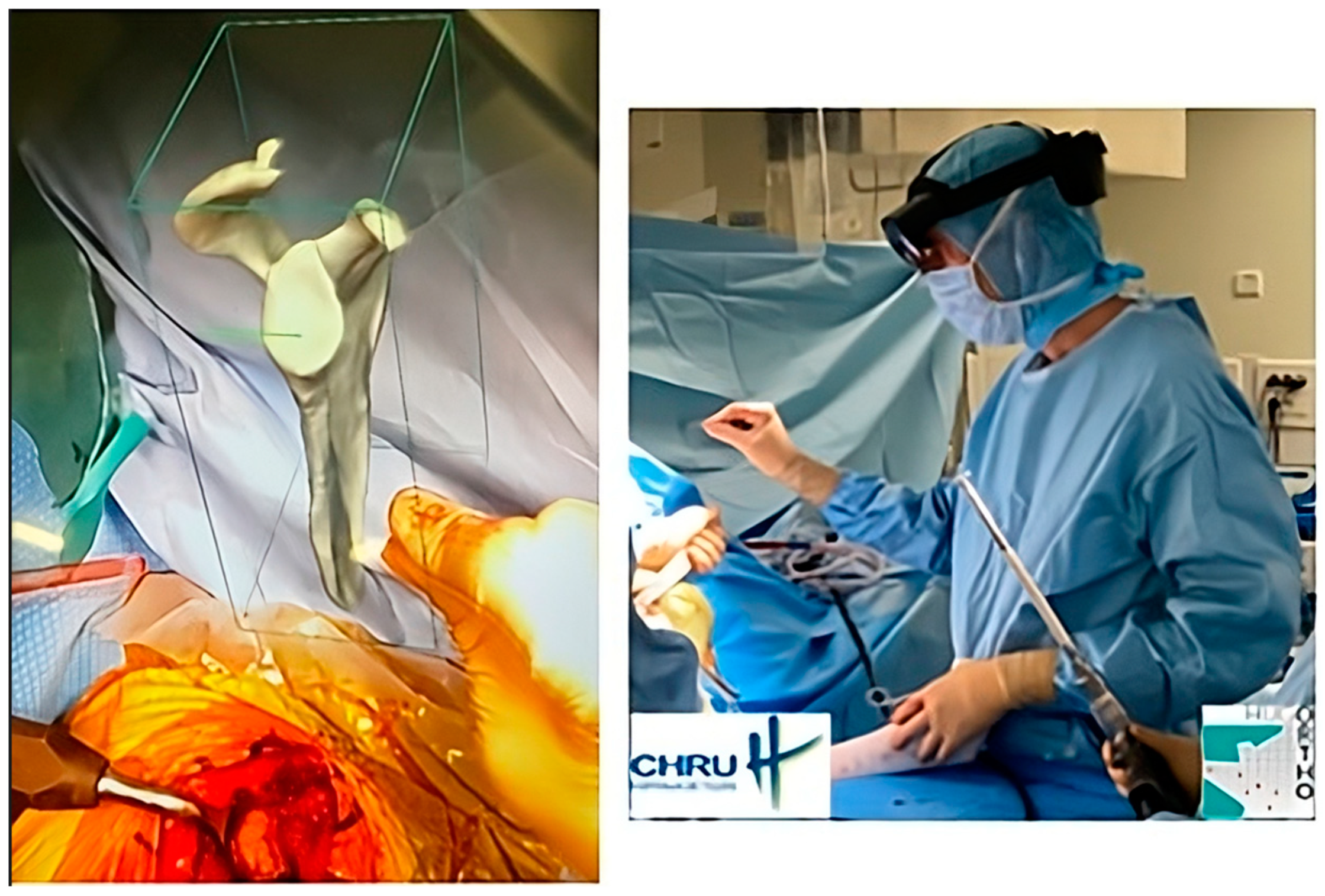
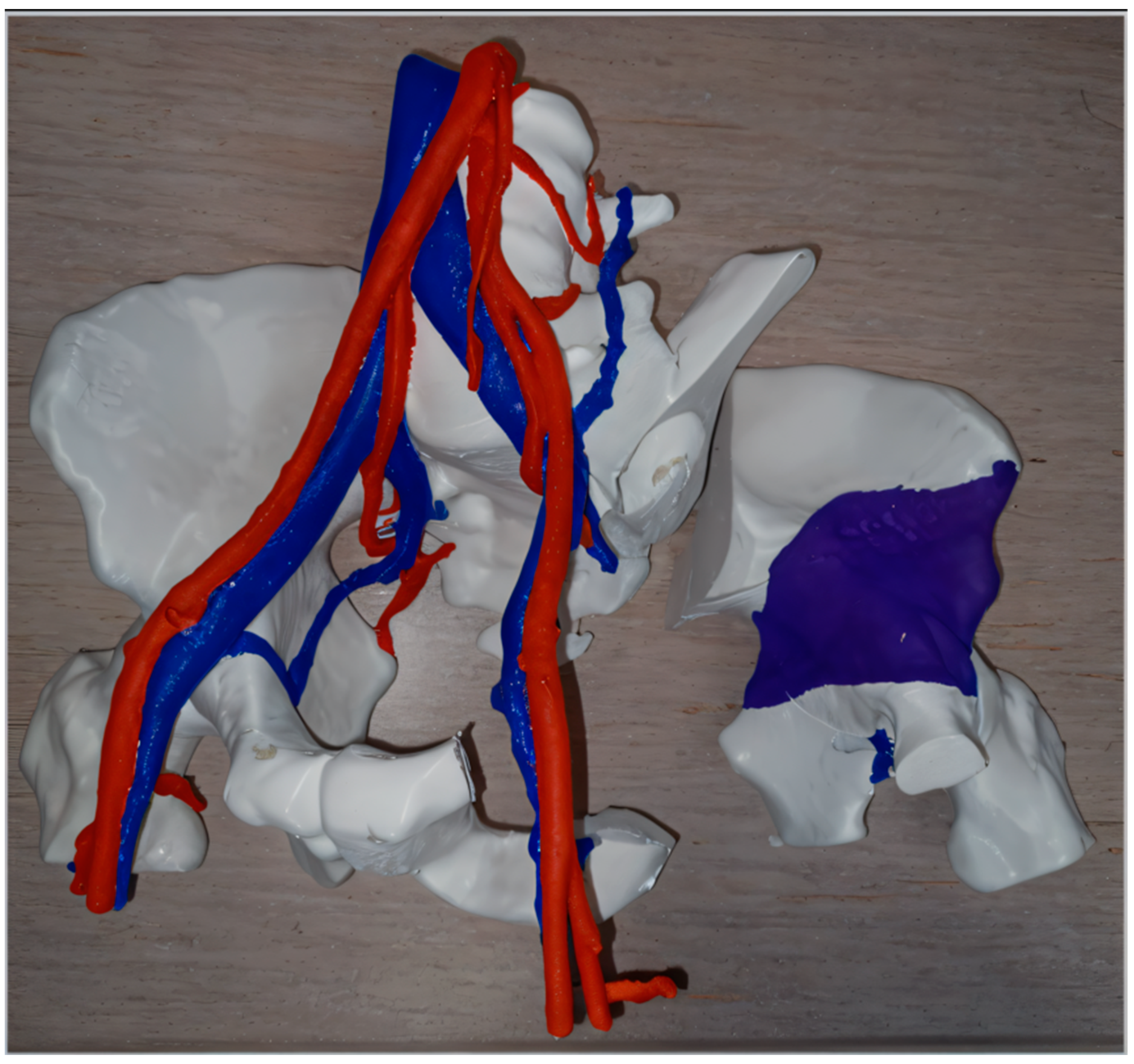
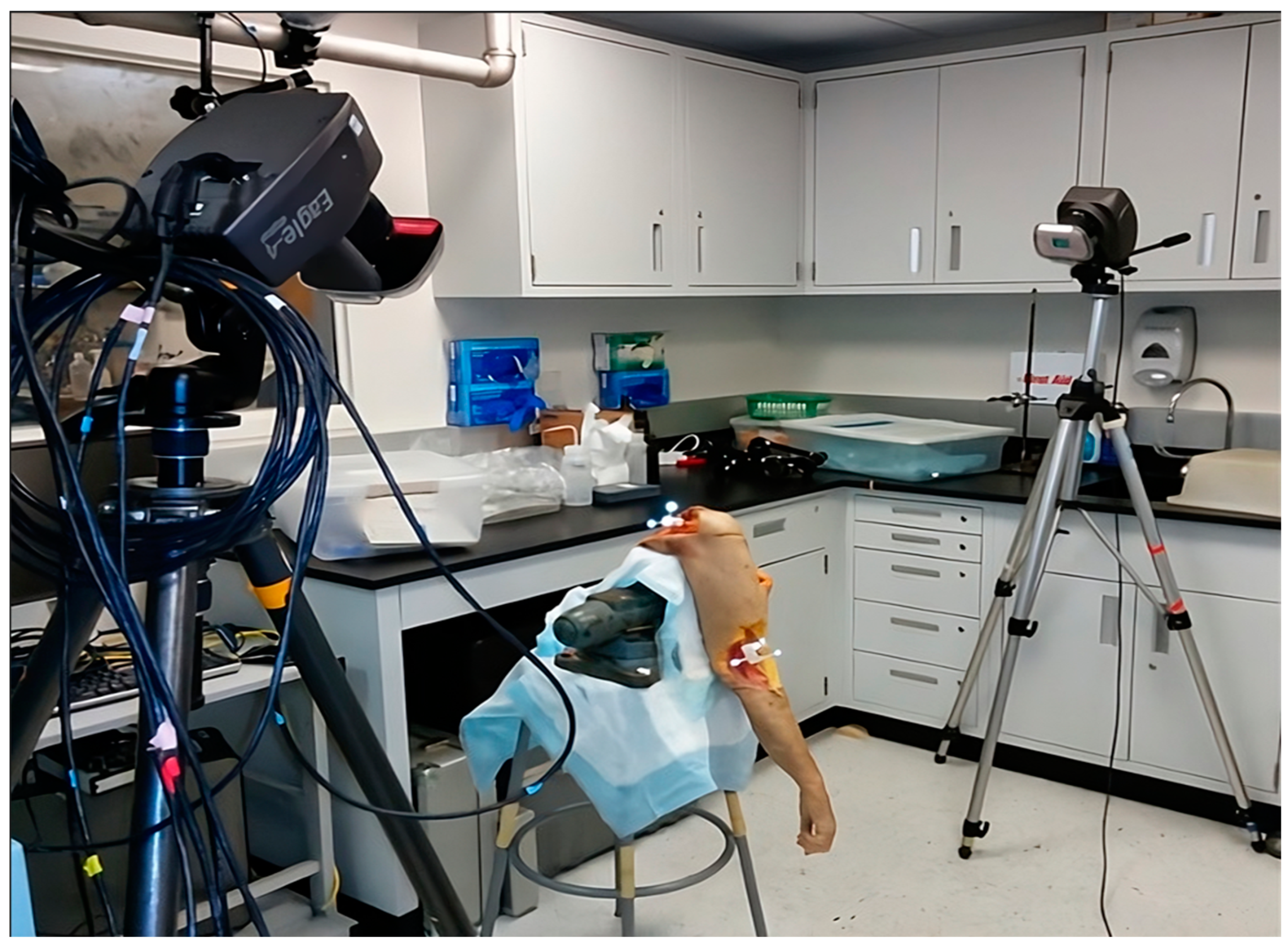
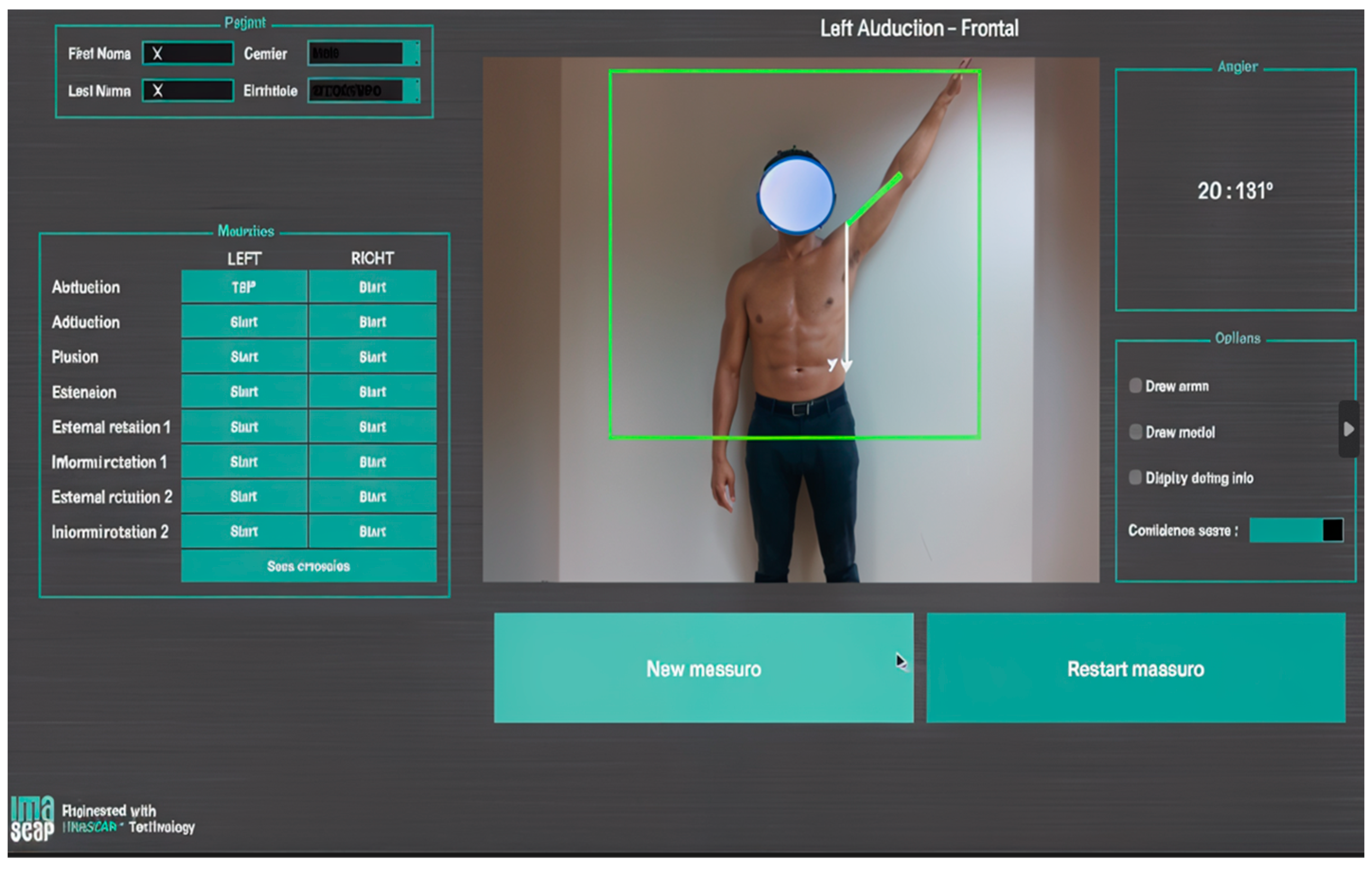
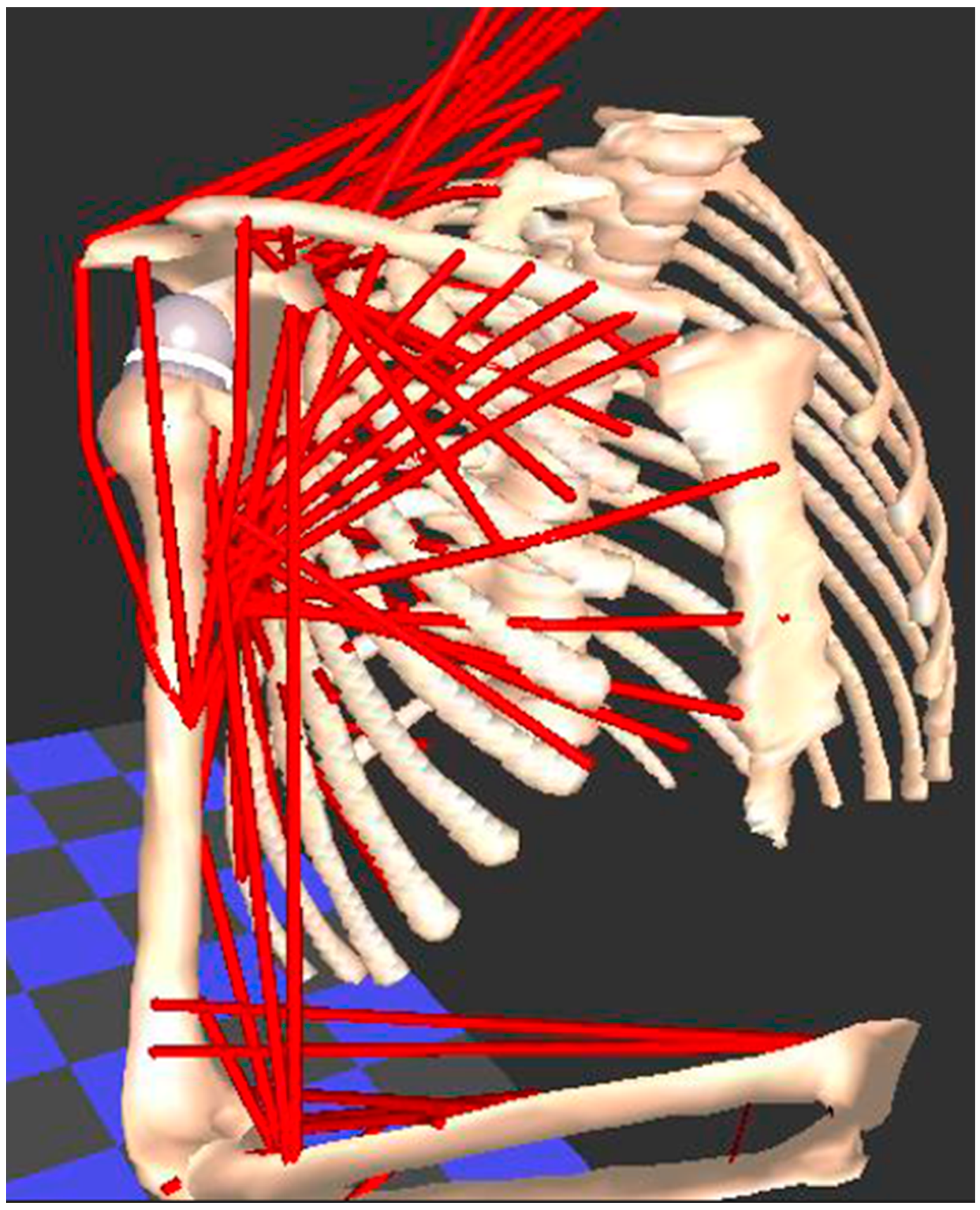
Disclaimer/Publisher’s Note: The statements, opinions and data contained in all publications are solely those of the individual author(s) and contributor(s) and not of MDPI and/or the editor(s). MDPI and/or the editor(s) disclaim responsibility for any injury to people or property resulting from any ideas, methods, instructions or products referred to in the content. |
© 2024 by the authors. Licensee MDPI, Basel, Switzerland. This article is an open access article distributed under the terms and conditions of the Creative Commons Attribution (CC BY) license (https://creativecommons.org/licenses/by/4.0/).
Share and Cite
Berhouet, J.; Samargandi, R. Emerging Innovations in Preoperative Planning and Motion Analysis in Orthopedic Surgery. Diagnostics 2024, 14, 1321. https://doi.org/10.3390/diagnostics14131321
Berhouet J, Samargandi R. Emerging Innovations in Preoperative Planning and Motion Analysis in Orthopedic Surgery. Diagnostics. 2024; 14(13):1321. https://doi.org/10.3390/diagnostics14131321
Chicago/Turabian StyleBerhouet, Julien, and Ramy Samargandi. 2024. "Emerging Innovations in Preoperative Planning and Motion Analysis in Orthopedic Surgery" Diagnostics 14, no. 13: 1321. https://doi.org/10.3390/diagnostics14131321
APA StyleBerhouet, J., & Samargandi, R. (2024). Emerging Innovations in Preoperative Planning and Motion Analysis in Orthopedic Surgery. Diagnostics, 14(13), 1321. https://doi.org/10.3390/diagnostics14131321






